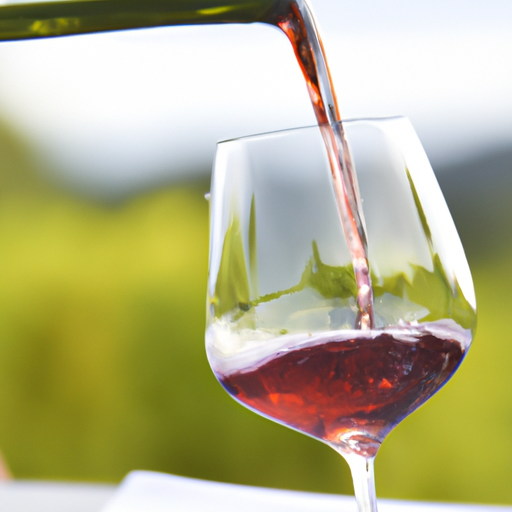Are you a food lover who also appreciates a good glass of wine? Well, you’re in for a treat! In this article, we’ll be diving into the world of food and wine pairings, exploring the delightful combinations that can elevate your dining experience. Buckle up, because we’re about to take your taste buds on a journey!
Imagine savoring a perfectly cooked steak accompanied by a full-bodied red wine that complements its rich flavors. Or how about indulging in a creamy pasta dish paired with a crisp white wine that cuts through the creaminess and refreshes your palate? The possibilities are endless when it comes to pairing food and wine, and we’re here to guide you through the process.
Throughout this article, we’ll be sharing some insider tips on how to create successful food and wine pairings, highlighting the key factors to consider when matching flavors. Whether you’re a novice or a seasoned foodie, you’ll find something valuable in our recommendations. So, get ready to expand your culinary horizons and experience the magic that happens when food and wine come together in perfect harmony.
Stay tuned as we explore different types of cuisines and their ideal wine companions, debunk common myths about food and wine pairings, and provide you with practical advice on how to approach pairing in any situation. Get ready to wow your taste buds and impress your friends and family with the ultimate food and wine combinations. Let’s get started!

Discover Delicious Food and Wine Pairings
Are you a food enthusiast who loves to explore different flavors and cuisines? Do you enjoy savoring a glass of wine while indulging in a delectable meal? If so, this article is for you. Here, we will delve into the world of food and wine pairings, helping you unlock the secrets to finding the perfect combination of flavors. Whether you prefer red, white, rosé, sparkling, or fortified wine, we will guide you through the different types of wine and their characteristics. Additionally, we will provide you with expert tips on pairing wine with various meats, cheeses, vegetables, seafood, pasta and rice, and even desserts. So, get ready to embark on a culinary journey that will tantalize your taste buds and ignite your passion for food and wine.
Different Types of Wine
Before diving into food and wine pairings, it is essential to understand the different types of wine available. Wine can be broadly categorized into five main types: red, white, rosé, sparkling, and fortified.
Red Wine
Red wine is made from dark-colored grapes and is typically known for its robust flavors and strong tannins. Some popular red wine varieties include Cabernet Sauvignon, Merlot, Pinot Noir, and Syrah. Red wine pairs exceptionally well with bold-flavored meats and dishes.
White Wine
White wine is made from light-colored grapes, and it is known for its refreshing and crisp taste. Varieties such as Chardonnay, Sauvignon Blanc, Riesling, and Pinot Grigio fall under the white wine category. White wine is often paired with dishes featuring lighter flavors and delicate proteins.
Rosé Wine
Rosé wine is made from red or black grapes, but the skins are only in contact with the juice for a short period, resulting in a beautiful pink hue. Rosé wines offer a wide range of flavors, from dry to slightly sweet, and are perfect for warm weather gatherings. They are incredibly versatile and can be paired with a variety of dishes.
Sparkling Wine
Sparkling wine is known for its effervescence and celebratory nature. The most famous sparkling wine is Champagne, but there are also other regional varieties, such as Prosecco and Cava. Sparkling wines are often enjoyed as an aperitif but can also be paired with a range of dishes.
Fortified Wine
Fortified wine is a wine to which a distilled spirit, such as brandy, has been added. This process makes the wine stronger and often sweeter. Port, Madeira, and Sherry are common examples of fortified wines. They are typically enjoyed as dessert wines or paired with cheese and nuts.
Understanding Wine Characteristics
To fully appreciate and enjoy the experience of pairing wine with food, it is crucial to understand various wine characteristics. Here are a few key characteristics to consider when selecting a wine for your meal:
Body
The body of a wine refers to its weight and texture. Wines can be light-bodied, medium-bodied, or full-bodied. Light-bodied wines are delicate and have a lower alcohol content. Medium-bodied wines fall in the middle, while full-bodied wines are robust and have a higher alcohol content. When pairing wine with food, consider the body of the wine and try to match it with the intensity of the dish.
Acidity
Acidity is an essential characteristic of wine that affects its taste and structure. Wines with high acidity are often crisp and refreshing, while those with low acidity can be rounder and smoother. Acidic wines pair well with rich and fatty foods as they help cut through the richness.
Tannin
Tannin is a naturally occurring compound found in red wine, primarily derived from grape skins, seeds, and stems. It gives red wine its astringency and bitterness. Some red wine varieties, like Cabernet Sauvignon and Nebbiolo, have higher tannin levels. Tannic wines pair well with fatty meats and dishes as the tannins help cleanse the palate.
Sweetness
Sweetness in wine can range from bone dry to lusciously sweet. Understanding the level of sweetness in a wine is crucial when pairing it with food. Sweeter wines pair well with spicy dishes, desserts, and cheeses, while drier wines complement savory dishes.
Aromas and Flavors
The aromas and flavors present in a wine can greatly enhance a dining experience. Wines can exhibit a wide range of aromas, such as fruity, floral, herbal, or oaky. Similarly, the flavors can vary from citrus and tropical fruits to earthy and spicy notes. When pairing wine with food, consider the aromas and flavors of both the wine and the dish to create harmonious pairings.
Pairing Wine with Meat
Meat dishes offer a wide range of flavors and textures, making them ideal for pairing with different types of wine. Here are some popular meat choices and their recommended wine pairings:
Beef
Beef dishes, such as steak or roast beef, pair wonderfully with full-bodied red wines such as Cabernet Sauvignon, Bordeaux, or Malbec. The rich flavors and textures of the beef are complemented by the tannins and intensity of these red wines.
Pork
Pork can be prepared in various ways, from tenderloin to ribs and chops. For lighter pork dishes, such as grilled pork tenderloin or pork chops, opt for a medium-bodied red wine, like Pinot Noir or Merlot. If the pork is prepared with rich sauces or spices, a bolder red like Syrah or Zinfandel can provide a delightful pairing.
Lamb
Lamb has a distinct flavor that pairs beautifully with medium to full-bodied red wines. Cabernet Sauvignon, Syrah, and Bordeaux blends are excellent choices when enjoying a lamb dish, whether it’s grilled lamb chops or slow-cooked lamb stew.
Chicken
Chicken is a versatile protein that can be prepared in numerous ways, from roasted chicken to grilled chicken breast or creamy chicken dishes. For roasted or grilled chicken, white wines like Chardonnay or Sauvignon Blanc make delicious pairings. Creamy chicken dishes, on the other hand, can be complemented by a slightly oaked Chardonnay or a light-bodied red wine like Pinot Noir.
Fish
Fish dishes offer a lighter and more delicate flavor profile, requiring a different approach to wine pairing. Here are some recommendations for pairing wine with different types of fish:
-
Shrimp and Shellfish: Light-bodied white wines, such as Sauvignon Blanc or Albariño, complement the delicate flavors of shrimp and shellfish.
-
Salmon and Trout: Salmon and trout have a richer and oilier taste, which pairs beautifully with medium-bodied white wines like Chardonnay or Pinot Gris.
-
White Fish: White fish dishes, such as cod or sole, can be paired with crisp and unoaked white wines like Sauvignon Blanc or Chenin Blanc.
-
Tuna and Swordfish: The meaty texture of tuna and swordfish can stand up to medium and full-bodied white wines, such as Viognier or Chardonnay.
-
Octopus and Calamari: These seafood delicacies are known for their tenderness. Pair them with light-bodied white wines like Pinot Grigio or Vinho Verde for a delightful combination.
Pairing Wine with Cheese
Cheese is a versatile and flavorful accompaniment to wine. When it comes to pairing wine with cheese, it’s essential to consider the intensity and texture of the cheese. Here are some popular cheese choices and their recommended wine pairings:
Soft Cheeses
Soft cheeses like Brie or Camembert have a creamy and mild flavor. These cheeses pair well with light-bodied white wines such as Chardonnay or Sauvignon Blanc. The crisp acidity of the white wine balances the richness of the cheese, creating a harmonious pairing.
Hard Cheeses
Hard cheeses like aged Cheddar or Parmesan have a nutty and robust flavor. These cheeses pair wonderfully with full-bodied red wines like Cabernet Sauvignon or Syrah. The bold flavors of the cheese are complemented by the tannins and intensity of the red wine.
Blue Cheeses
Blue cheeses, such as Gorgonzola or Roquefort, have a pungent and tangy flavor. These cheeses pair well with sweet fortified wines such as Port or Sauternes. The sweetness of the wine balances the strong flavors of the cheese, creating a delightful contrast.
Goat Cheeses
Goat cheeses like Chèvre or Bucheron have a distinct and slightly tangy flavor. These cheeses pair well with crisp and citrusy white wines such as Sauvignon Blanc or Chenin Blanc. The acidity of the wine counteracts the acidity in the cheese, creating a refreshing and balanced pairing.
Creamy Cheeses
Creamy cheeses like cream cheese or triple cream Brie have a rich and buttery flavor. These cheeses pair well with medium-bodied white wines such as Chardonnay or Pinot Gris. The wine’s richness complements the creamy texture of the cheese, creating a luxurious pairing.
Pairing Wine with Vegetables
Vegetables offer a wide range of flavors, from earthy to sweet and bitter. When pairing wine with vegetables, it’s crucial to consider the preparation method and the dominant flavors. Here are some popular vegetable choices and their recommended wine pairings:
Leafy Greens
Leafy greens like spinach or kale have a slightly bitter and earthy taste. These vegetables pair well with crisp and refreshing white wines such as Sauvignon Blanc or Pinot Grigio. The wine’s acidity cuts through the bitterness, enhancing the flavors of the greens.
Root Vegetables
Root vegetables like carrots or beets have a sweet and earthy flavor. These vegetables pair well with medium-bodied white wines such as Chardonnay or Chenin Blanc. The wine’s richness complements the sweetness of the vegetables, creating a well-balanced pairing.
Cruciferous Vegetables
Cruciferous vegetables like broccoli or cauliflower have a slightly bitter and nutty taste. These vegetables pair well with light-bodied red wines such as Pinot Noir or Gamay. The wine’s acidity and fruitiness counterbalance the bitterness, enhancing the flavors of the vegetables.
Nightshade Vegetables
Nightshade vegetables like tomatoes or eggplants have a rich and savory flavor. These vegetables pair well with medium-bodied red wines such as Sangiovese or Merlot. The wine’s acidity and fruitiness complement the robust flavors of the vegetables, creating a harmonious pairing.
Squash and Pumpkin
Squash and pumpkin varieties have a sweet and nutty flavor. These vegetables pair well with medium to full-bodied white wines such as Chardonnay or Viognier. The wine’s richness and fruity notes complement the natural sweetness of the vegetables, creating a delightful pairing.
Pairing Wine with Seafood
Seafood offers a delicate and nuanced flavor profile, making it an ideal candidate for wine pairing. Here are some popular seafood choices and their recommended wine pairings:
Shrimp and Shellfish
Shrimp and shellfish have a sweet and slightly briny flavor. These seafood delicacies pair well with light-bodied white wines such as Sauvignon Blanc or Albariño. The crisp acidity of the wine enhances the flavors of the shrimp and shellfish.
Salmon and Trout
Salmon and trout have a rich and oily taste. These fish pair well with medium-bodied white wines such as Chardonnay or Pinot Gris. The wine’s richness complements the natural oils in the fish, creating a well-balanced pairing.
White Fish
White fish varieties like cod or haddock have a delicate and mild flavor. These fish pair well with crisp and unoaked white wines such as Sauvignon Blanc or Chenin Blanc. The wine’s acidity and fresh flavors enhance the subtlety of the fish.
Tuna and Swordfish
Tuna and swordfish have a meaty and robust texture. These fish pair well with medium to full-bodied white wines such as Viognier or Chardonnay. The wine’s intensity stands up to the meatiness of the fish, creating a flavorful combination.
Octopus and Calamari
Octopus and calamari offer a tender and slightly chewy texture. These seafood delicacies pair well with light-bodied white wines such as Pinot Grigio or Vinho Verde. The wine’s crispness complements the tenderness of the octopus and calamari.
Pairing Wine with Pasta and Rice
Pasta and rice dishes are beloved comfort foods, and the right wine can elevate their flavors. Here are some popular pasta and rice dishes and their recommended wine pairings:
Creamy Pasta
Creamy pasta dishes like Fettuccine Alfredo or Carbonara have a rich and velvety texture. These dishes pair well with medium-bodied white wines such as Chardonnay or Viognier. The wine’s richness complements the creaminess of the pasta, creating a luscious pairing.
Tomato-Based Pasta
Tomato-based pasta dishes like Spaghetti Bolognese or Penne Arrabiata have a bold and tangy flavor. These dishes pair well with medium-bodied red wines such as Sangiovese or Barbera. The wine’s acidity and fruitiness complement the acidity in the tomato sauce, creating a well-balanced pairing.
Seafood Pasta
Seafood pasta dishes like Linguine alle Vongole or Shrimp Scampi have a delicate and fresh flavor. These dishes pair well with light-bodied white wines such as Sauvignon Blanc or Vermentino. The wine’s crispness and citrusy notes enhance the seafood flavors in the pasta.
Mushroom Risotto
Mushroom risotto has a creamy and earthy taste. This dish pairs well with medium-bodied red wines such as Pinot Noir or Barbera. The wine’s fruitiness complements the earthy flavors of the mushrooms, creating a harmonious pairing.
Fried Rice
Fried rice dishes like Yangzhou Fried Rice or Pineapple Fried Rice have a combination of sweet and savory flavors. These dishes pair well with off-dry white wines such as Riesling or Gewürztraminer. The wine’s sweetness balances the savory and slightly spicy flavors of the fried rice.
Pairing Wine with Desserts
No meal is complete without a sweet ending. Desserts offer a multitude of flavors and textures, and the right wine can elevate the sweetness. Here are some popular dessert choices and their recommended wine pairings:
Chocolate
Chocolate desserts like chocolate cake or brownies have a rich and decadent flavor. These desserts pair well with sweet red wines such as Port or Banyuls. The wine’s sweetness and intense flavors complement the richness of the chocolate.
Fruit-Based Desserts
Fruit-based desserts like apple pie or fruit tarts have a sweet and tangy flavor. These desserts pair well with off-dry white wines such as Moscato or Riesling. The wine’s fruitiness and acidity enhance the natural sweetness of the fruits.
Cheesecake
Cheesecake has a creamy and slightly tangy taste. This dessert pairs well with sweet white wines such as Late Harvest Riesling or Sauternes. The wine’s sweetness balances the tanginess of the cheesecake, creating a delicious combination.
Ice Cream
Ice cream offers a refreshing and creamy texture. It pairs well with sweet dessert wines such as Muscat or Ice Wine. The wine’s sweetness and fruity flavors complement the cold and creamy ice cream.
Puddings and Custards
Puddings and custards have a smooth and velvety texture. These desserts pair well with sweet fortified wines such as Madeira or Sherry. The wine’s sweetness and nutty flavors enhance the creamy indulgence of the puddings and custards.
Choosing the Right Wine Glass
To fully enjoy the flavors and aromas of your chosen wine, it is important to serve it in the appropriate glass. Here are some common wine glass types and their recommended wines:
Red Wine Glasses
Red wine glasses have a wider bowl and a larger opening, allowing for better aeration and the release of aromas. They are suitable for serving medium to full-bodied red wines such as Cabernet Sauvignon or Merlot.
White Wine Glasses
White wine glasses have a slightly smaller bowl compared to red wine glasses. This design helps maintain the wine’s cooler temperature and concentrate the aromas. They are suitable for serving light to medium-bodied white wines such as Chardonnay or Sauvignon Blanc.
Sparkling Wine Glasses
Sparkling wine glasses, also known as flutes, have a tall and narrow design to preserve the bubbles. The shape allows for better effervescence and enhances the wine’s aromas. They are suitable for serving sparkling wines such as Champagne or Prosecco.
Fortified Wine Glasses
Fortified wine glasses are similar to red wine glasses but are generally slightly smaller in size. They are suitable for serving fortified wines such as Port or Sherry, allowing the aromas to be concentrated.
Universal Glasses
If you don’t have specific wine glasses for each wine type, a universal glass is a versatile option that works well for most wines. Look for a glass with a tulip-shaped bowl that narrows towards the rim. This design helps capture the wine’s aromas and allows for proper aeration.
Conclusion
Pairing food and wine is an art that can elevate your dining experience to new heights. By understanding the different types of wine and their characteristics, as well as considering the flavors and textures of the food, you can create harmonious and memorable pairings. From meats and cheeses to vegetables, seafood, pasta and rice, and desserts, there is a perfect wine waiting to be discovered. So, gather your favorite dishes, pour a glass of your preferred wine, and embark on a culinary adventure that will tantalize your taste buds and leave you craving for more. Cheers to delicious food and wine pairings!



